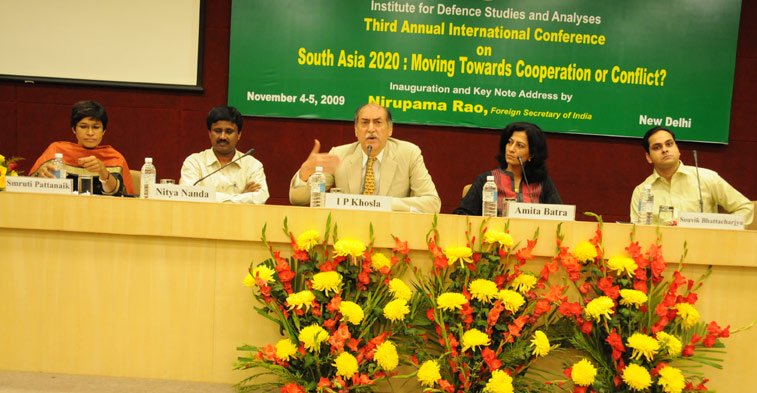You are here

Rapporteur Report on Session IV
November 4, 2009
Role of the Regional Organization in the future of South Asia
This session examined the role of regional organizations in shaping multilateral cooperation. Multilateral cooperation is weak within South Asia. The speakers explored ways in which multilateral cooperation can be enhanced and the challenges regional states confront in overcoming impediments to greater cooperation.
Amita Batra: “Future of regional Cooperation : case study of BIMSTEC” Dr. Batra examined the Bay of Bengal Initiative for Multi-Sectoral, Technical and Economic Cooperation (BIMSTEC) in terms of its potential for widening the network for outward oriented growth. She argued that BIMSTEC can emerge as a bridge between South Asia and Southeast Asia. She highlighted that the agenda and membership of BIMSTEC overlaps with other groupings such as SAARC and ARF, so a cautious step is needed before India embarks on so many regional groupings. Dr. Batra, however, disagreed with India’s position that BIMSTEC would provide greater linkages to India’s Northeastern States and thus it will lead to overall development of the region and instead suggested that India should take the initiative to link the region on its own rather than depending on countries such as Thailand.
Nityananda and Souvik Bhattacharya: “Regional Economic Integration and SAFTA: What does it portend?” SAARC members’ initiative to promote regional trade has achieved “limited success”; they cited reasons such as weak governance, political frictions, limited tariff reduction and prevalence of sizeable informal trade for this state of affairs. They stated that the trade imbalance between India and some other regional partners are another contentious issue that remains from the inception. They opined that the size of India and its economic policies, with huge diversification, have resulted in restricted complementarities and reduced trade opportunities. However, citing the European example, they argued that trade integration is neither a necessary nor a sufficient condition for promoting regional peace and cooperation. They also stated that SAARC countries suffer from poor communications links, which prevents them from being connected to the global economy and suggested that communication within the SAARC countries needs to be expedited to make it a strong regional economic bloc. One suggestion they made was that India should try to dispel the misperception of its dominance in the region and opined that it would be difficult for India to secure a better place in the global community if it is not able to take its neighbours along. They also said that other countries can gain by joining forces with India as it often gets more attention due to its size, population and market. Thus a win-win situation can be created where both India and its neighbours can mutually benefit.
Smruti Pattanik: “Does SAARC have a future?”: Dr. Pattanaik noted that SAARC summit meetings do not generate excitement either in the people or draw the attention of the media and opined that SAARC has not achieved its potential given various political impediments stunting its progress. Her thrust was to highlight the fact that the people of the region should be involved in the process and it should not be driven by the Foreign Ministries of member states. NGOs and civil society should also be involved, so that people feel that it is their initiative. Highlighting the need for “people to people contact,” she advocated that the existing liberal visa regime is only limited to Members of Parliament and Judges of the SAARC countries and should be extended to academics, journalists, and common people and warned that unless the common man benefits regional cooperation will be doomed. Dr. Pattanaik highlighted that SAARC continues to be relevant. First, the forum provides a meeting ground for all the leaders of South Asia to meet in a regional context. Second, the SAARC process has established the sovereign equality of member-states for determining the regional agenda. For instance, both Nepal and Bhutan joined SAARC to play a visible regional role and enhance their foreign policy choices. It also creates a sense of involvement of all states thereby creating stakeholders in the process. Third, SAARC provides for sub-regional cooperation (Articles VII and X of its charter) among geographically contiguous countries, thus providing scope to go beyond the India-Pakistan bilateral context which tends to stymie any progress. Dr. Pattanaik hoped that sub-regional cooperation would be the new term for regional co-operation and opined that regional co-operation cannot be kept hostage to intractable bilateral problems. It needs to be kept in mind that when the SAARC charter was signed, except for India and Sri Lanka all other countries were non-democratic. With democracy now established in all SAARC countries, synergies can be reached on issues.
Q&A and Comments
- It was suggested that SAARC should have a permanent Secretariat, that it should take up doable joint ventures and complete these within a time frame.
- SAARC should have a Secretary General with a status equivalent to a Cabinet Minister.
- SAARC should form a joint peace keeping group to participate in UN Peacekeeping.
- Think tanks in the region should sit together and work as a nodal agency, presenting their suggestions to reinvigorate the agenda of SAARC.
- It is not as if India and Pakistan do not co-operate at all. There are instances where India and Pakistan have taken a common position in WTO, on climate change, etc. This could be emulated in other areas as well.
Prepared by Shamshad Khan, Research Assistant at the Institute for Defence Studies and Analysis.
